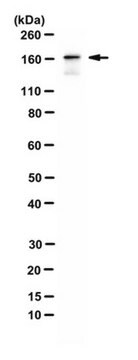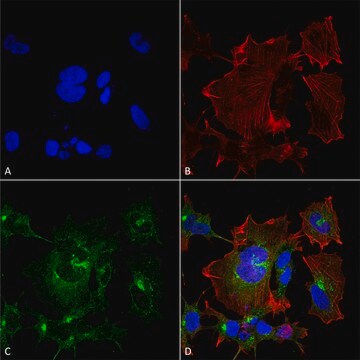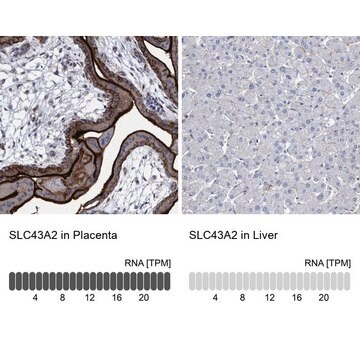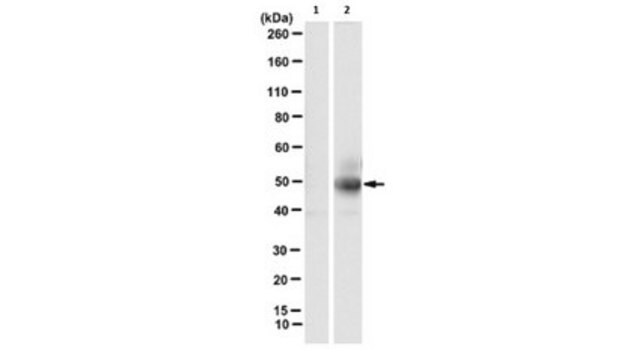推荐产品
生物源
rabbit
品質等級
共軛
unconjugated
抗體表格
affinity isolated antibody
抗體產品種類
primary antibodies
無性繁殖
polyclonal
分子量
48 kDa
物種活性
human
濃度
0.5 mg - 1 mg/mL
技術
western blot: suitable
NCBI登錄號
UniProt登錄號
運輸包裝
wet ice
儲存溫度
−20°C
目標翻譯後修改
unmodified
基因資訊
human ... KCNN4(3783)
一般說明
Potassium intermediate/small conductance calcium-activated channel, subfamily N, member 4, KCNN4, is a component of a potassium channel activated by calcium. It is critically involved in calcium ion transport and cell homeostasis.
免疫原
Synthetic peptide directed towards the C terminal region of human KCNN4
應用
Anti-KCNN4 antibody produced in rabbit has been used in:
- western blot analysis
- immunofluorescence
- staining
- immunohistochemistry
生化/生理作用
KCNN4 (potassium calcium-activated channel subfamily N member 4) is part of a potentially heterotetrameric voltage-independent potassium channel that is activated by intracellular calcium. Activation is followed by membrane hyperpolarization, which promotes calcium influx. KCNN4 may be part of the predominant calcium-activated potassium channel in T-lymphocytes. Activation is followed by membrane hyperpolarization, which promotes calcium influx. The encoded protein may be part of the predominant calcium-activated potassium channel in T-lymphocytes. This gene is similar to other KCNN family potassium channel genes, but it differs enough to possibly be considered as part of a new subfamily.
序列
Synthetic peptide located within the following region: DLQQNLSSSHRALEKQIDTLAGKLDALTELLSTALGPRQLPEPSQQSK
外觀
Purified antibody supplied in 1x PBS buffer with 0.09% (w/v) sodium azide and 2% sucrose.
免責聲明
Unless otherwise stated in our catalog or other company documentation accompanying the product(s), our products are intended for research use only and are not to be used for any other purpose, which includes but is not limited to, unauthorized commercial uses, in vitro diagnostic uses, ex vivo or in vivo therapeutic uses or any type of consumption or application to humans or animals.
未找到合适的产品?
试试我们的产品选型工具.
儲存類別代碼
10 - Combustible liquids
水污染物質分類(WGK)
WGK 2
閃點(°F)
Not applicable
閃點(°C)
Not applicable
Epigenetic dysregulation of KCa3. 1 channels induces poor prognosis in lung cancer
Bulk E, et al.
International Journal of Cancer. Journal International Du Cancer, 137(6), 1306-1317 (2015)
A Novel Gene, hKCa4, Encodes the Calcium-activated Potassium Channel in Human T Lymphocytes
Logsdon NJ, et al.
The Journal of Biological Chemistry, 272(52), 32723-32726 (1997)
Bradykinin-induced chemotaxis of human gliomas requires the activation of KCa3. 1 and ClC-3
Cuddapah VA, et al.
The Journal of Neuroscience, 33(4), 1427-1440 (2013)
D Strøbæk et al.
British journal of pharmacology, 168(2), 432-444 (2012-08-16)
The K(Ca) 3.1 channel is a potential target for therapy of immune disease. We identified a compound from a new chemical class of K(Ca) 3.1 inhibitors and assessed in vitro and in vivo inhibition of immune responses. We characterized the
Javier Lozano-Gerona et al.
PloS one, 15(3), e0222619-e0222619 (2020-03-10)
Ion channels have recently attracted attention as potential mediators of skin disease. Here, we explored the consequences of genetically encoded induction of the cell volume-regulating Ca2+-activated KCa3.1 channel (Kcnn4) for murine epidermal homeostasis. Doxycycline-treated mice harboring the KCa3.1+-transgene under the
我们的科学家团队拥有各种研究领域经验,包括生命科学、材料科学、化学合成、色谱、分析及许多其他领域.
联系技术服务部门








